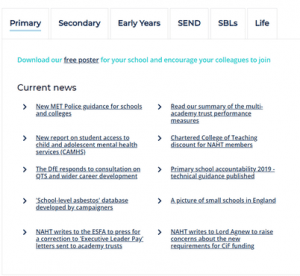Dave Gilmore
Head of Communications, NAHT
Membership organisations are complex, and one of the most challenging aspects of their complexity is effectively communicating their message to multiple audiences.
More often than not, these types of organisation will comprise people with different categories of membership, and, more often than not, these people will have different backgrounds, interests, and reasons for joining the organisation.
Let’s take my current employers as an example. NAHT represents over 30,000 school leaders in England, Wales and Northern Ireland. ‘Ah, head teachers!’ I hear you say, but you’d be wrong! Yes, head teachers make up a large part of our membership, but we also represent:
- Deputy heads
- Assistant heads
- School business leaders
- Special educational needs co-ordinators
- Subject and year heads (as part of NAHT Edge)
The role that our members have can matter greatly in relation to what they might want to hear from us on, but so does the setting in which they work. Our members operate in various settings, including:
- Primary schools
- econdary schools
- Nurseries
- Special educational needs schools
- Multi-academies trusts
And these are in either England, Northern Ireland or Wales, all of which have fairly different legislation and situations when it comes to the state of education.
NAHT also has 13,000 ‘life members’; retired school leaders who wish to retain the benefits of membership now their professional careers have concluded.
So, a rich mix of members in terms of roles and settings at various stages in their careers, and guess what? They all want:
Relevant, frequent, timely, specific and engaging communications based on their own needs and experiences.
OK, I’ve just come back from counting how many people work for me and it’s still only three, so we probably need to sit down and think about this.
But before we do and to further compound the challenge, NAHT also has a number of committees and officials banging the drum for their own area of membership to be given more prominence. This is of course entirely understandable (in fact, it’s their job to do so) but giving one group extra column inches over another on the basis they shouted the loudest does not a robust communications strategy make.
Five years ago, NAHT was tackling the problem of communicating with different audiences the obvious way: by sending separate e-newsletters to as many of the key membership groups as possible containing all the information deemed relevant to them.
This is of course, a perfectly legitimate way of segmenting content, but it’s hugely resource-intensive for small comms teams; during this period our content officers would scarcely find time to do anything other than build and send these emails.
Moreover, we simply don’t want to communicate with members in a way that builds isolated audiences – it runs contrary to our collectivist nature and works against the idea of us building a community that considers themselves to be NAHT members first and foremost, before any other distinction comes into play. We’ve never suggested to our members that we’ll be a trade union that speaks specifically to their circumstances all of the time. We wouldn’t be able to do so, and even if we could, we wouldn’t want to.
All that said, we do still have to create a comms offer that makes people feel like NAHT is the right association for them.
So how do we make this work in practice?
Firstly, it’s important to realise that, while different member groups have different expectations, not all of those expectations require the same approach. In fact, we could probably place our audience types into four different categories:
Category one: For some audiences, almost all our content would be relevant. We’d place head teachers in primary schools (our biggest membership area) in this category.
Category two: Other audiences, such as our deputy and assistant heads, find most of our core content is relevant to them but still value being sent occasional content that directly reflects their own experience. Let’s pop them in here.
Category three: Some types of member, for example school business leaders or heads of early years schools, benefit from receiving our mainstream content but also value more frequent and specific content regarding their role, school environment or membership class to make their membership experience relevant.
Category four: This category is for membership types for who, the bulk of our general content just doesn’t bear relevance due to their role, setting, or location being so far removed. Members in Northern Ireland and Wales would fit in this category due to policy and legislative issues being so significantly different.
So what do we do to service members in these different categories in a practical way that doesn’t require an army of content officers?
Below is an example of how we might address the various audience’s comms needs (this is a bit simplistic, but you get the idea):
Category one members
These audiences would receive our regular communications (newsletter, magazine etc) with little or no segmentation.
Category two members
These audiences will receive our regular communications, but we will solicit additional content from members within these groups that will be of specific interest (for example, a magazine article on balancing classroom and management responsibilities aimed at deputy heads).
Category three members
We’ve found that dynamic content blocks in our e-news come in handy for these audiences. This way, we can ensure that they receive the same headlines as everyone else, but we’ll include dynamic content based on their role/school/membership class to make sure they feel like they’re getting something especially for them. For example, middle leaders receive their newsletter with an introduction from the director of NAHT Edge, rather than the general secretary, and this intro might focus slightly more on classroom issues which helps make the rest of the newsletter feel a bit more relevant.
Category four members
There’s no doubt that sending completely irrelevant information to a member is a sure-fire way to alienate them, so we’ve opted these audiences out of our standard communications and instead send them less frequent updates but ensuring that what they do get is 100% relevant to them.
Getting robots to do it
 Tailoring content to fit a members’ circumstances is all very well and good, but we often get feedback from some individuals who have a particular interest in an area outside of their current role or setting. To this end, we’re starting to offer them the opportunity to sign up to mailing lists to receive the latest news in their areas of interest. Signing up to these mailing lists enrols them into an automated monthly email programme, which contains a template which is automatically populated with relevant content through RSS feeds on our website. No staff power needed, but a nifty way of allowing members to engage with the content they want.
Tailoring content to fit a members’ circumstances is all very well and good, but we often get feedback from some individuals who have a particular interest in an area outside of their current role or setting. To this end, we’re starting to offer them the opportunity to sign up to mailing lists to receive the latest news in their areas of interest. Signing up to these mailing lists enrols them into an automated monthly email programme, which contains a template which is automatically populated with relevant content through RSS feeds on our website. No staff power needed, but a nifty way of allowing members to engage with the content they want.
Something to note
There isn’t a single defining factor that our members universally consider to be the key most important thing relating to their identity. For some people, their role is the most important thing that they want us to consider, but for others, it’s what area of the sector they work in. Others, such as our life members, would consider being in that category of membership to be the key factor, so we need to pick what’s important for them. To that end, we’ve segmented the membership area of our website to reflect this.
Ten quick tips on membership segmentation
- Know your audience needs – categorise by requirement
- Listen to what audiences are telling you, and what they’re clicking on
- Dynamic blocks in all-member emails can help strike a balance between top-line and more specific content
- What can you get robots to do for you? Low effort + high impact
- More audiences means increased content demand. Get them contributing for you
- Assign your comms staff to cover different audiences so that someone is always thinking about their requirements
- If you have the system, use your CRM to expose relevant content on your website, if not, can you display it in other ways?
- Give priority messaging a relevance rating per audience
- Make sure your member proposition is clear about what your audiences can expect
And finally, if your overall key message doesn’t work for one of your audiences, change your key message!
 NAHT is democratically run and supports its members through offering unparalleled protection and representation. It is committed to developing the profession through the excellent training opportunities we offer, and we use our highly-respected collective voice to influence the policy decisions of government.
NAHT is democratically run and supports its members through offering unparalleled protection and representation. It is committed to developing the profession through the excellent training opportunities we offer, and we use our highly-respected collective voice to influence the policy decisions of government.










Leave A Comment